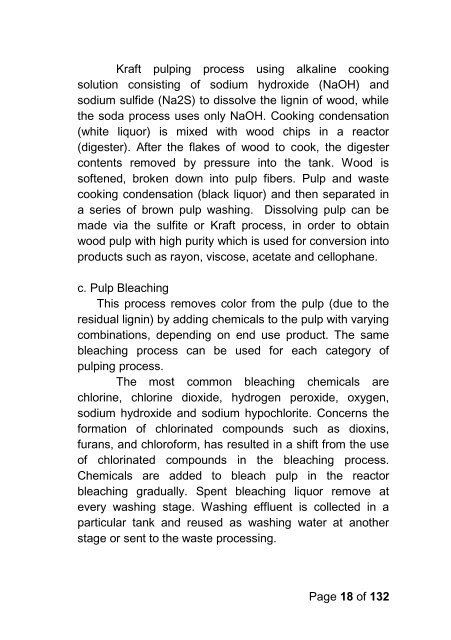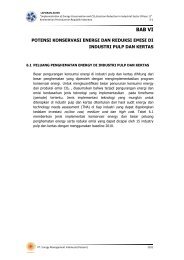- Page 2 and 3:
KEMENTERIAN PERINDUSTRIAN BALAI BES
- Page 4 and 5:
PEDOMAN PEMETAAN TEKNOLOGI DI INDUS
- Page 6 and 7:
RINGKASAN EKSEKUTIF Perkembangan pe
- Page 8 and 9:
delignifikasi berlanjut (extended d
- Page 10 and 11:
potensi untuk dimanfaatkan. Atas da
- Page 12 and 13:
3.4. Optimasi kinerja Chemical Reco
- Page 14 and 15:
DAFTAR GAMBAR Gambar 1.1. Prediksi
- Page 16 and 17:
Tabel 3.1 Konservasi energi pada pe
- Page 18 and 19:
umi naik 0,5 o C, angka ini akan na
- Page 20 and 21:
kertas, industri tekstil, indusri k
- Page 22 and 23:
Gambar 1.1 Prediksi Emisi GRK di In
- Page 24 and 25:
tahun 2009, perusahaan industri pul
- Page 26 and 27:
pulp dan kertas dibandingkan dengan
- Page 28 and 29:
Tabel 1.8 Rincian Besaran Emisi Kar
- Page 30 and 31:
Pada pembuatan pulp mekanis lignin
- Page 32 and 33:
Gambar 2.1 Diagram Proses Pabrik Pu
- Page 34 and 35:
(misalnya, dissolving, non-kayu). P
- Page 36 and 37:
meningkatkan kandungan padatannya m
- Page 38 and 39:
Kondensat Recovery boiler Panas sek
- Page 40 and 41:
dari proses pemulihan kembali bahan
- Page 42 and 43:
Gambar 2.5 Distribusi Konsumsi Ener
- Page 44 and 45:
2.3.1 Pengelolaan Limbah cair Ditin
- Page 46 and 47:
Teknologi pengelolaan melalui peman
- Page 48 and 49:
BAB III TEKNOLOGI PROSES PULPING HE
- Page 50 and 51:
Tabel 3.1 Konservasi energi pada pe
- Page 52 and 53:
Gambar 3.2 Dimensi tumpukan serpih
- Page 54 and 55:
Gambar 3.4 Ringkasan berbagai siklu
- Page 56 and 57:
yang selanjutnya disimpan dalam hot
- Page 58 and 59:
Gambar 3.6 Digester kontinyu dengan
- Page 60 and 61:
Ringkasan konservasi energi pada pa
- Page 62 and 63:
wash master. Dilution factor sekita
- Page 64 and 65:
Tabel 3.4 Konservasi energi pada si
- Page 66 and 67:
3.5 Optimasi kinerja Power Boiler b
- Page 68 and 69:
Tabel 3.5.Konservasi energi pada si
- Page 70 and 71:
Konservasi energi lain yang dapat d
- Page 72 and 73:
4.1.2 Mesin Kertas : Bagian Pembent
- Page 74 and 75:
ditingkatkan dari 15 % menjadi 60 -
- Page 76 and 77:
Tabel 4.1 Perbandingan Kinerja Tekn
- Page 78 and 79:
Tabel 4.2 Peluang Penghematan Energ
- Page 80 and 81:
Tabel 4.4 Sumber Emisi Karbon pada
- Page 82 and 83:
BAB V PENGELOLAAN LINGKUNGAN PADA I
- Page 84 and 85:
diutamakan untuk mengolah air limba
- Page 86 and 87:
Untuk mengoptimalkan dan mendistrib
- Page 88 and 89:
5.1.2 Pengembangan Teknologi Anaero
- Page 90 and 91:
merupakan sumber karbon yang berkon
- Page 92 and 93:
Gambar 5.1 Fase-Fase Pada Tahapan P
- Page 94 and 95:
memasang peralatan seperti turbin,
- Page 96 and 97:
5.2.2.1.a. Rotary Kiln Incinerator
- Page 98 and 99:
Di Indonesia, penerapan insinerator
- Page 100 and 101:
mikroba termofilik. Pada suhu di at
- Page 102 and 103:
5.2.3.1.b. Proses pengomposon siste
- Page 104 and 105:
zat organik telah dipertimbangkan s
- Page 106 and 107:
Gambar 5.8 Digestasi Anaerobik Satu
- Page 108 and 109:
meningkatkan produktivitas berbagai
- Page 110 and 111:
menyebabkan terjadinya pencemaran u
- Page 112 and 113:
Gambar 5.10. (A). Cyclone dan Multi
- Page 114 and 115:
Gambar 5.12. Electrostatic Precipit
- Page 116 and 117:
disemprotkan dan mengalir ke bawah
- Page 118 and 119:
Counter Current Packed Tower Bubble
- Page 120 and 121:
Metode FGD Metode Kering Absorben R
- Page 122 and 123:
NOx yang terbentuk sebagai hasil pe
- Page 124 and 125:
Metoda Non selective catalytic redu
- Page 126 and 127:
BAB VI PENUTUP Indonesia ikut berpe
- Page 128 and 129:
Teknologi pengelolaan lingkungan me
- Page 130 and 131: Gavrilescu, D. 2008. “Energy from
- Page 132 and 133: Stultz, S.C., and J.B. Kitto., 2000
- Page 134 and 135: No Company Name APPENDIX 1 DISTRIBU
- Page 136 and 137: LANJUTAN No Company Name Mill Site
- Page 138 and 139: LANJUTAN No Company Name Mill Site
- Page 140 and 141: APPENDIX 2 PAPER CONSUMPTION IN VAR
- Page 142 and 143: APPENDIX 2 (continuation) Country C
- Page 144 and 145: Coated wood-free paper - integrated
- Page 146 and 147: APPENDIX 4 ENERGY CONSUMPTION FOR U
- Page 149 and 150: MINISTRY OF INDUSTRY CENTER FOR PUL
- Page 151 and 152: TECHNOLOGY MAPPING GUIDELINE FOR PU
- Page 153 and 154: EXECUTIVE SUMMARY The development o
- Page 155 and 156: pulp bleaching done by adding a hea
- Page 157 and 158: device SOx and NOx and also control
- Page 159 and 160: 3.3 Application Washing Technologie
- Page 161 and 162: Figure 3.7 Black Liquor Impregnatio
- Page 163 and 164: Table 3.5 Conservation Of Energy In
- Page 165 and 166: 15% CH4, CFCs by 12% and 4% N2O, an
- Page 167 and 168: governments and stakeholders as a b
- Page 169 and 170: Figure 1.1 Forecast of GHG Emission
- Page 171 and 172: paper industry in Indonesia are 81
- Page 173 and 174: Table 1.5 Specific Energy Consumpti
- Page 175 and 176: Table 1.8 Details of Carbon Emissio
- Page 177 and 178: have a good opacity, and easy to ab
- Page 179: Figure 2.1 Process Diagram of Kraft
- Page 183 and 184: urned, and Na2SO4 reduced to Na2S.
- Page 185 and 186: Kondensat Recovery boiler Secondary
- Page 187 and 188: Pulp mills in Indonesia fulfill the
- Page 189 and 190: The main energy source used in the
- Page 191 and 192: alkaline pH, high contamination COD
- Page 193 and 194: will be generated carbon emission s
- Page 195 and 196: CHAPTER III PULPING TECHNOLOGY FOR
- Page 197 and 198: Table 3.1 Conservation Of Energy In
- Page 199 and 200: Figure 3.1 Mechanism of chip damage
- Page 201 and 202: Figure 3.3 Cycle Of Displacement Ba
- Page 203 and 204: Figure 3.5 System RDH equipment / S
- Page 205 and 206: With a uniform temperature througho
- Page 207 and 208: Table 3.2 Conservation Of Energy in
- Page 209 and 210: 3.3 Application Washing Technologie
- Page 211 and 212: Udara kuaterner Udara sekunder ting
- Page 213 and 214: sootblowing intelligent sootblowing
- Page 215 and 216: Figure 3.11 FBC and CFBC Page 52 of
- Page 217 and 218: Other energy conservation can be do
- Page 219 and 220: process of separating water from th
- Page 221 and 222: facilities. For the hood that uses
- Page 223 and 224: 4.2 Saving Energy and Carbon Emissi
- Page 225 and 226: Table 4.3 Best 2009 World Energy In
- Page 227 and 228: Table 4.5 Overview of Investment Fo
- Page 229 and 230: chemistry, and biology process or a
- Page 231 and 232:
ii. b. Anaerobic System Anaerobic p
- Page 233 and 234:
experience growth to form granular
- Page 235 and 236:
Table 5.1. Sources and Types of Sol
- Page 237 and 238:
There are several solid waste manag
- Page 239 and 240:
technology development is equipped
- Page 241 and 242:
esulting energy for steam productio
- Page 243 and 244:
With this system, the fluidization
- Page 245 and 246:
In the composting process temperatu
- Page 247 and 248:
closed system requires an investmen
- Page 249 and 250:
generally composed of CH 4 55-70%;
- Page 251 and 252:
Figure 5.8 Anaerobic Digestion One
- Page 253 and 254:
Figure 5.9 Flowchart of Two Phase A
- Page 255 and 256:
Table 5.4 Sources and Characteristi
- Page 257 and 258:
5.3.2.1 Separation of Particulate P
- Page 259 and 260:
). Filter Cloth (Fabric Filter) The
- Page 261 and 262:
time. Separation of pollutants carr
- Page 263 and 264:
Figure 5.14 Packed Tower Scrubber B
- Page 265 and 266:
C. SOx Gas Control SOx gases can be
- Page 267 and 268:
Type of FGD Method Dry Method Absor
- Page 269 and 270:
D. NOx Gas Control NOx emission can
- Page 271 and 272:
Method Selective non catalytic redu
- Page 273 and 274:
incoming gas fan. To avoid the risk
- Page 275 and 276:
Some processes that can save energy
- Page 277 and 278:
REFERENCES Adams, Terry N., 1997,.
- Page 279 and 280:
Industry”, Environmental Energy T
- Page 281 and 282:
_____EPA, 2010. “Available and Em
- Page 283 and 284:
CONTINUE No Company Name Mill Site
- Page 285 and 286:
CONTINUE No Company Name Mill Site
- Page 287 and 288:
CONTINUE No Company Name Mill Site
- Page 289 and 290:
APPENDIX 2 (continuation) Consumpti
- Page 291 and 292:
APPENDIX 3 SPECIFIC ENERGY CONSUMPT
- Page 293 and 294:
Source : all data taken from [249,
- Page 295:
APENDIX 4 GHG EMISSION FROM VARIOUS



